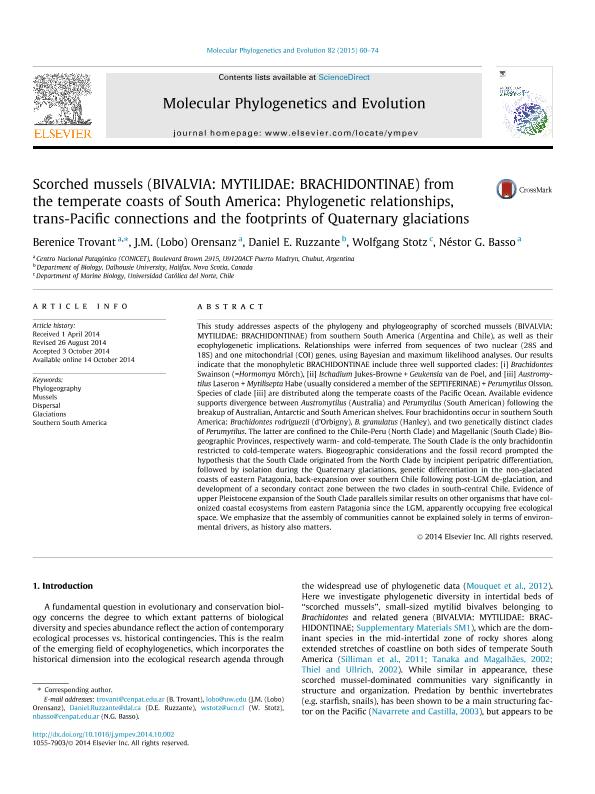Mostrar el registro sencillo del ítem
dc.contributor.author
Trovant, Berenice

dc.contributor.author
Orensanz, Jose Maria

dc.contributor.author
Ruzzante, Daniel E.

dc.contributor.author
Stotz, Wolfgang

dc.contributor.author
Basso, Nestor Guillermo

dc.date.available
2017-05-19T15:21:53Z
dc.date.issued
2015
dc.identifier.citation
Trovant, Berenice; Orensanz, Jose Maria; Ruzzante, Daniel E.; Stotz, Wolfgang; Basso, Nestor Guillermo; Scorched mussels (Bivalvia: Mytilidae: Brachidontinae) from the temperate coasts of South America: phylogenetic relationships, trans-Pacific connections and the footprints of quaternary glaciations; Elsevier Inc; Molecular Phylogenetics and Evolution; 82; Part A; -1-2015; 60-74
dc.identifier.issn
1055-7903
dc.identifier.uri
http://hdl.handle.net/11336/16720
dc.description.abstract
This study addresses aspects of the phylogeny and phylogeography of scorched mussels (BIVALVIA: MYTILIDAE: BRACHIDONTINAE) from southern South America (Argentina and Chile), as well as their ecophylogenetic implications. Relationships were inferred from sequences of two nuclear (28S and 18S) and one mitochondrial (COI) genes, using Bayesian and maximum likelihood analyses. Our results indicate that the monophyletic BRACHIDONTINAE include three well supported clades: [i] Brachidontes Swainson (= Hormomya Mörch), [ii] Ischadium Jukes-Browne + Geukensia van de Poel, and [iii] Austromy- tilus Laseron + Mytilisepta Habe (usually considered a member of the SEPTIFERINAE) + Perumytilus Olsson. Species of clade [iii] are distributed along the temperate coasts of the Pacific Ocean. Available evidence supports divergence between Austromytilus (Australia) and Perumytilus (South American) following the breakup of Australian, Antarctic and South American shelves. Four brachidontins occur in southern South America: Brachidontes rodriguezii (d’Orbigny), B. granulatus (Hanley), and two genetically distinct clades of Perumytilus . The latter are confined to the Chile-Peru (North Clade) and Magellanic (South Clade) Bio- geographic Provinces, respectively warm- and cold-temperate. The South Clade is the only brachidontin restricted to cold-temperate waters. Biogeographic considerations and the fossil record prompted the hypothesis that the South Clade originated from the North Clade by incipient peripatric differentiation, followed by isolation during the Quaternary glaciations, genetic differentiation in the non-glaciated coasts of eastern Patagonia, back-expansion over southern Chile following post-LGM de-glaciation, and development of a secondary contact zone between the two clades in south-central Chile. Evidence of upper Pleistocene expansion of the South Clade parallels similar results on other organisms that have col- onized coastal ecosystems from eastern Patagonia since the LGM, apparently occupying free ecological space. We emphasize that the assembly of communities cannot be explained solely in terms of environ- mental drivers, as history also matters.
dc.format
application/pdf
dc.language.iso
eng
dc.publisher
Elsevier Inc

dc.rights
info:eu-repo/semantics/openAccess
dc.rights.uri
https://creativecommons.org/licenses/by-nc-nd/2.5/ar/
dc.subject
Phylogeography
dc.subject
Mussels
dc.subject
Dispersal
dc.subject
Glaciations
dc.subject
Southern South America
dc.subject.classification
Biología Marina, Limnología

dc.subject.classification
Ciencias Biológicas

dc.subject.classification
CIENCIAS NATURALES Y EXACTAS

dc.title
Scorched mussels (Bivalvia: Mytilidae: Brachidontinae) from the temperate coasts of South America: phylogenetic relationships, trans-Pacific connections and the footprints of quaternary glaciations
dc.type
info:eu-repo/semantics/article
dc.type
info:ar-repo/semantics/artículo
dc.type
info:eu-repo/semantics/publishedVersion
dc.date.updated
2017-05-04T17:08:40Z
dc.journal.volume
82
dc.journal.number
Part A
dc.journal.pagination
60-74
dc.journal.pais
Países Bajos

dc.journal.ciudad
Amsterdam
dc.description.fil
Fil: Trovant, Berenice. Consejo Nacional de Investigaciones Científicas y Técnicas. Centro Científico Tecnológico Conicet - Centro Nacional Patagónico.; Argentina
dc.description.fil
Fil: Orensanz, Jose Maria. Consejo Nacional de Investigaciones Científicas y Técnicas. Centro Científico Tecnológico Conicet - Centro Nacional Patagónico.; Argentina
dc.description.fil
Fil: Ruzzante, Daniel E.. Dalhousie University Halifax; Canadá
dc.description.fil
Fil: Stotz, Wolfgang. Universidad Católica de Chile; Chile
dc.description.fil
Fil: Basso, Nestor Guillermo. Consejo Nacional de Investigaciones Científicas y Técnicas. Centro Científico Tecnológico Conicet - Centro Nacional Patagónico.; Argentina
dc.journal.title
Molecular Phylogenetics and Evolution

dc.relation.alternativeid
info:eu-repo/semantics/altIdentifier/doi/http://dx.doi.org/10.1016/j.ympev.2014.10.002
dc.relation.alternativeid
info:eu-repo/semantics/altIdentifier/url/http://www.sciencedirect.com/science/article/pii/S1055790314003534
Archivos asociados
